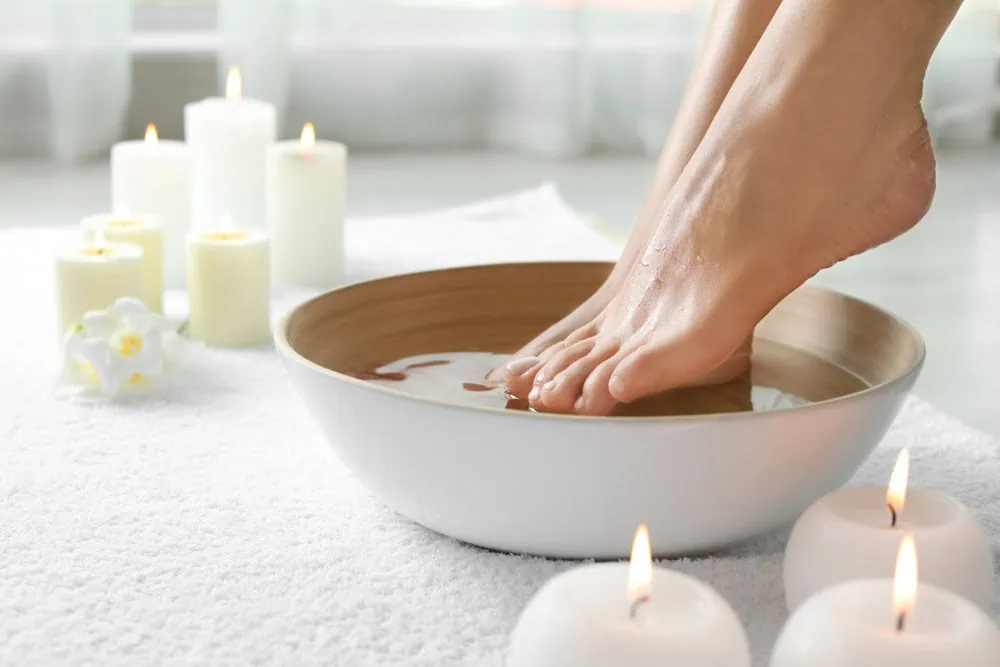
Toenail fungus is common and persistent, but foot soaks for toenail fungus may help relieve symptoms—especially when started early. Known medically as onychomycosis, toenail fungus often causes the nail to turn yellow, become thickened, or crumble. Less frequently, it may appear white or chalky.
This type of infection often comes along with athlete’s foot (tinea pedis), caused by the same fungus. It can spread from floors, showers, or shoes. While many people assume it’s highly contagious, the truth is that your immune system plays a significant role in whether you develop a fungal infection. People with diabetes or compromised immune systems tend to experience fungal nail issues more frequently. Interestingly, one partner in a household might have toenail fungus while the other never gets it.
How to Prevent Toenail Fungus
Preventing toenail fungus involves good foot hygiene and environmental awareness. Avoid walking barefoot in public showers or locker rooms. Keep your feet dry at all times, and make sure to dry thoroughly between the toes after bathing.
Choose breathable footwear, especially if your feet sweat often. Using baking soda and hydrogen peroxide inside your shoes can help keep them fresh and less inviting to fungus. Learn more about our diabetic foot care recommendations to reduce your risk of infection.
Start Early With Treatment
Start treating toenail fungus as soon as you notice symptoms. Early treatment improves your chances of success, especially with home remedies. However, toenails grow slowly—it can take 9 to 12 months for a full nail to regrow. Be patient, and monitor for results.
If you don’t see improvement after 3–4 months of at-home care, make an appointment with a podiatrist near you. If you have diabetes or see cracks, thickening, or pain in the nails, seek medical advice right away.
Why Nail Fungus Shouldn’t Be Ignored
Toenail fungus can distort the shape of your nail, making it more prone to becoming ingrown. If you notice yellowing, thickening, pain, or an odor around the nail, don’t wait—these are signs of worsening infection.
Professional care can prevent complications, especially for patients with circulation issues or weakened immune systems. Visit our foot and ankle conditions page for more details.
Home Remedies and Foot Soaks for Toenail Fungus
Soaking your feet daily can be a simple and soothing way to support fungal nail treatment. Here are some of the most recommended foot soaks for toenail fungus:
Listerine Foot Soak
Some people believe that Listerine has antifungal properties. To try it, mix 30–50 ml of Listerine in 2 cups of warm water and soak your feet for 30 minutes daily.
This soak may also improve dry, scaly skin. If you have sensitive skin, test a small area before doing a full soak.
Apple Cider Vinegar Soak
Create a soak using:
- 1/3 cup white vinegar
- 2 cups warm water
- 1/3 cup Epsom salt
Soak your entire foot for 30 minutes once a day. Some even take apple cider vinegar orally for potential internal antifungal benefits. The acetic acid in vinegar may help kill fungus.
Additional Topical Remedies
Tea Tree Oil
Tea tree oil is a natural antifungal essential oil. Clean the nail with rubbing alcohol, then apply a few drops of tea tree oil directly. Other essential oils like peppermint or cinnamon oil may offer similar effects.
Olive Leaf Extract
Known for its antifungal, antibacterial, and antiviral properties, olive leaf extract can be taken orally or applied topically. You can find it online or in health food stores.
When Home Remedies Aren’t Enough
If your toenail fungus doesn’t improve, it’s time to seek professional treatment. Podiatrists offer options that have been clinically tested and often work more quickly than home remedies.
Medical Topical Treatments
These include over-the-counter and prescription creams or solutions. Our clinic offers a proprietary topical treatment that penetrates the nail more effectively than most.
Oral Antifungal Medications
Oral treatments like Lamisil can be effective, but they may affect the liver. We rarely recommend them unless absolutely necessary and always advise liver function testing beforehand.
Laser Nail Treatment
Laser toenail fungus treatment is our most popular option. It uses painless, pulsed energy to heat and destroy fungal cells inside the nail. For thick nails, we often grind them down first to improve results and appearance.
Foot soaks for toenail fungus are a helpful starting point, but medical treatment may be necessary for full recovery. Our staff and podiatrists were the first to bring this type of treatment for nail fungus to the Colorado region. Our clinics in Fort Collins and Broomfield locations were among the first in the region to offer this advanced laser therapy. If you’ve searched for a “local podiatrist near me,” we’re ready to help.
What to Expect During a Podiatrist Visit
During your visit, the podiatrist will:
- Examine your feet
- Review your symptoms
- Take nail samples to identify the fungus
- Recommend a treatment plan
They may suggest prescription medications, laser nail fungus treatment therapy, or other targeted approaches. They’ll also guide you on preventing future infections, so you can maintain long-term foot health.
Frequently Asked Questions: Foot Soaks for Toenail Fungus
How Do You Get Rid of Toenail Fungus?
Treatment may include over-the-counter antifungal products, prescription meds, or nail removal in severe cases. Regular trimming and filing help the treatment reach deeper.
What Kills Toenail Fungus Instantly?
No treatment kills it instantly, but laser therapy and medications like terbinafine are highly effective over time.
How Do You Know If Toenail Fungus Is Dying?
Signs include less discoloration, thinner nails, reduced odor, and healthy nail growth from the base.
Is Hydrogen Peroxide Good for Toenail Fungus?
Yes, it has antifungal properties. Use it alone or in a soak. However, it’s generally not strong enough for severe cases.
What Are the Best Home Remedies for Toenail Fungus?
- Tea Tree Oil: Apply directly after cleaning
- Vinegar Soaks: Use apple cider vinegar and water
- Baking Soda: Absorbs moisture, preventing fungal growth
- Garlic: Apply crushed garlic or take it in supplement form
- Hydrogen Peroxide: Mild but useful antifungal soak


